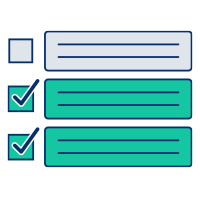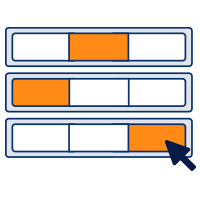We know you’ve read “Product Research 101: The Beginner’s Guide to Product Research,” so you likely already know how to write questions to produce a great survey. Wait, you haven’t read it yet? There’s no time like the present. Here you go: “Product Research 101: The Beginner’s Guide to Product Research.”
Let’s start again. Now that you know some question-writing best practices for creating a survey that supports your learning objective, it’s time to consider what type of questions you want to use. The questions you choose will be dictated by what you want to learn.
There are six primary types of questions to help you elicit truthful consumer feedback. The DISQO CX platform can do the work for you, using both cutting-edge technology and super-smart humans to choose the most effective type of questions for a given situation. Leveraging DISQO Experience Suite is the easiest way to conduct effective consumer research.
But if you want to know when, why, and how to do it on your own, “Product Research 201: The Intermediate Guide to De-Risking Decisions” has you covered. It includes detailed explanations of all six types of questions, along with step-by-step instructions on when to use which.
Types of survey questions

1. Single-select: Single-select questions give test participants a list of options to select from, and they can select one answer. Use single-select questions when the response options to a question are well-defined, and it is important to know exactly which option a participant prefers.

2. Multi-select: Multi-select questions give test participants a list of options to select from, and they can select multiple answers. Use multi-select questions when the answers to a question are well-defined, but a range of possible choices is preferred.
 3. Rate: Rate questions give users a rating scale, along with a dimension on which to rate. There are two basic types of scales for rate questions: Unipolar (e.g., not at all likely to extremely likely) assesses degrees of a single factor, while bipolar (e.g., extremely unlikely to extremely likely) assesses degrees of opposing factors. Use rate questions to measure reactions by agreement level, interest level, satisfaction level, importance, etc.
3. Rate: Rate questions give users a rating scale, along with a dimension on which to rate. There are two basic types of scales for rate questions: Unipolar (e.g., not at all likely to extremely likely) assesses degrees of a single factor, while bipolar (e.g., extremely unlikely to extremely likely) assesses degrees of opposing factors. Use rate questions to measure reactions by agreement level, interest level, satisfaction level, importance, etc. 
4. Matrix: Matrix questions are a set of up to eight rate questions measured along with a single variable. Use matrix questions to learn how participants rate multiple variables along the same scale dimension. For example, test participants may be asked to rate the usefulness of several features of an app. In matrix questions, each variable is presented individually rather than in a traditional grid format. 
5. Open-ended response: Open-ended response questions present the participant with an open text box to respond to a question. Use open-ended response questions to ask test participants to describe an experience or when there is not a well-defined set of options that would best answer the question. 
6. Rank: Rank questions give participants the ability to put answer options in order according to certain attributes, such as importance or usefulness. The ranking arrangement should be easy for test participants to understand (e.g., “rank the following in terms of importance, where first is most important and last is least important”). Use rank questions to determine participants’ preferences among a group of things.
Each type of question has its perils. If you’re not using a platform to automatically choose the right question for the right situation, you’ll want some additional help to prevent missteps. “Product Research 201: The Intermediate Guide to De-Risking Decisions” includes sage advice for avoiding the common mistakes associated with each type of question, as well as helpful hints to ensure you’ll get meaningful answers on your survey.
Download the Product Research 201 Guide




